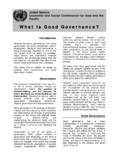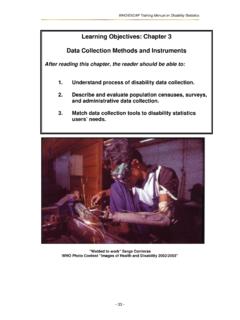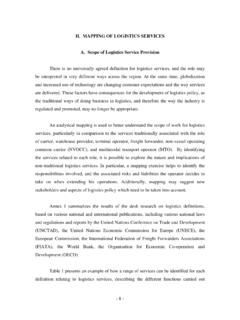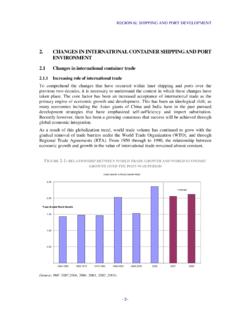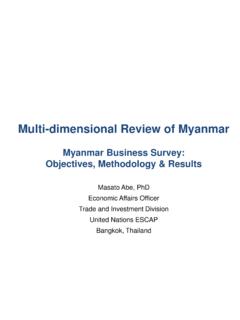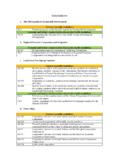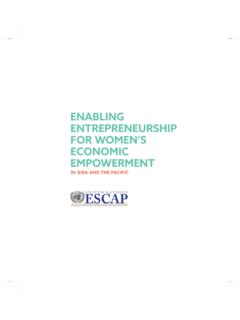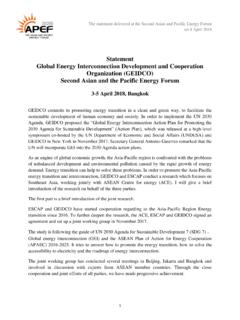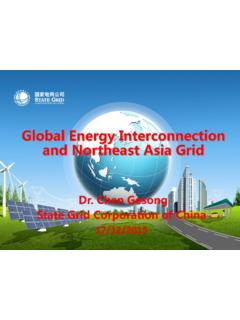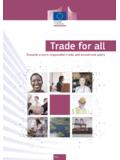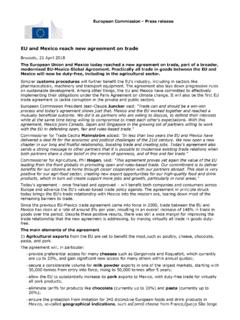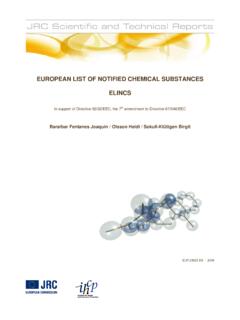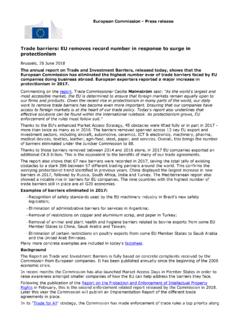Transcription of On the economic impact of FDI and trade …
1 ASIA-PACIFIC RESEARCH AND TRAINING NETWORK ON trade Working Paper NO. 171 | 2017 On the economic impact of FDI and trade liberalization in the Asia-Pacific region: A structural quantitative analysis Mario Larch Yoto V. Yotov The Asia-Pacific Research and Training Network on trade (ARTNeT) is an open regional network of research and academic institutions specializing in international trade policy and facilitation issues. ESCAP, WTO, UNCTAD as key core network partners, and a number of bilateral development partners provide substantive and/or financial support to the network. The trade , Investment and Innovation Division of ESCAP, the regional branch of the United Nations for Asia and the Pacific, provides the Secretariat of the network and a direct regional link to trade policymakers and other international organizations.
2 The ARTNeT Working Paper Series disseminates the findings of work in progress to encourage the exchange of ideas about trade issues. An objective of the series is to publish the findings quickly, even if the presentations are less than fully polished. ARTNeT Working Papers are available online at All material in the Working Papers may be freely quoted or reprinted, but acknowledgment is requested, together with a copy of the publication containing the quotation or reprint. The use of the Working Papers for any commercial purpose, including resale, is prohibited. Disclaimer: The designations employed and the presentation of the material in this Working Paper do not imply the expression of any opinion whatsoever on the part of the Secretariat of the United Nations concerning the legal status of any country, territory, city or area, or of its authorities, or concerning the delimitation of its frontiers or boundaries. Where the designation country or area appears, it covers countries, territories, cities or areas.
3 Bibliographical and other references have, wherever possible, been verified. The United Nations bears no responsibility for the availability or functioning of URLs. The views expressed in this publication are those of the author(s) and do not necessarily reflect the views of the United Nations. The opinions, figures and estimates set forth in this publication are the responsibility of the author(s), and should not necessarily be considered as reflecting the views or carrying the endorsement of the United Nations. Any errors are the responsibility of the author(s). The mention of firm names and commercial products does not imply the endorsement of the United Nations. ARTNeT 2017 On the economic impact of FDI and trade liberalization in the Asia-Pacific region: A structural quantitative analysis Mario Larch* and Yoto V. Yotov** We are very grateful for the excellent feedback, comments and suggestions that we received from the participants in the Expert Group Meeting on Channeling trade and Investment into Sustainable Development in Asia and the Pacific, which took place on August 8, 2017, in Bangkok, Thailand, as well as for financial support from ESCAP secretariat toward undertaking this research which serves as a background material for Asia-Pacific trade and Investment Report 2017: Channelling trade and Investment into Sustainable Development (forthcoming).
4 * University of Bayreuth, CESifo, CEPII and ifo Institute ** Drexel University, CESifo and ERI-BAS Please cite this paper as: Mario Larch and Yoto V. Yotov (2017), On the economic impact of FDI and trade Liberalization in the Asia-Pacific Region: A Structural Quantitative Analysis , ARTNeT Working Paper Series, No. 171, October 2017, Bangkok, ESCAP. Available at: WORKING PAPER ASIA-PACIFIC RESEARCH AND TRAINING NETWORK ON trade i Abstract We employ the structural model of trade and investment from Anderson, Larch and Yotov (2017) in order to quantify the impact of Foreign Direct Investment (FDI) and trade liberalization on exports and real GDP per capita in the Asia-Pacific region. Using a dataset of 89 countries for 2011, which covers more than 97 percent of the trade and investment activity in the ESCAP member countries form the Asia-Pacific region, we find that FDI has had a strong but heterogeneous impact on the economic performance of the countries in this region.
5 On average, our estimates reveal that FDI is responsible for 7% of exports, for 3% of physical capital accumulation, and for 7% of real GDP per capita in the Asia-Pacific region. We also find that a uniform 10% decrease of bilateral trade costs for all ESCAP members in our sample would have led to strong and positive, but quite heterogeneous, impact on exports and real GDP per capita in the Asia-Pacific region. Key words: FDI, trade liberalization, international trade JEL codes: F21, F13 ii Table of contents Abstract .. i 1. Introduction: Motivation and goals .. 1 2. Relation to literature .. 6 3. Theoretical foundations .. 11 A structural model of trade and investment .. 11 trade and investment liberalization in a global world: A discussion .. 15 On the economic impact of trade liberalization ..16 On the economic impact of FDI liberalization ..20 4. Data: Description and sources .. 22 5. On the impact of FDI and trade in the Asia-Pacific region .. 26 On the impact of FDI in the Asia-Pacific region.
6 26 On the impact of trade liberalization in the Asia-Pacific region .. 39 6. Concluding remarks, caveats and future work .. 42 References .. 1 Table of figures Figure 1: FDI impact on trade and the net FDI position (without HKG and SGP) .. 32 Figure 2: FDI impact on real GDP per capita and the production shares of FDI ( ) (without HKG and SGP) .. 35 Figure 3: Inward FDI and GDP per capita (without HKG and SGP) .. 36 Figure 4: Outward FDI and GDP per capita (without HKG and SGP) .. 36 Figure 5: FDI impact on real GDP per capita and net FDI position (without HKG and SGP) .. 37 Figure 6: FDI impact on real GDP per capita and the change in total exports (without HKG and SGP) .. 38 Table of tables Table 1: Summary of the model's endogenous variables, exogenous variables, and parameters .. 25 Table 2: On the economic impact of FDI and trade liberalization in the Asia-Pacific region .. 29 1 1. Introduction: Motivation and goals Over the past quarter century, the world witnessed an unprecedented wave of globalization efforts that often took the form of regional trade agreements and deeper integration agreements, including numerous bilateral investment treaties.
7 The Asia-Pacific region has played a central role in these integration efforts both in relation to trade and with respect to foreign direct investment. While the impact of trade liberalization has been studied extensively in the academic and in the policy literature, the effect of foreign direct investment (in part due to lack of data and in part due to the need for theoretical foundations that reflect the changing nature of FDI) is less studied and, therefore, less understood. Furthermore, notwithstanding obvious and intuitive links between trade liberalization and FDI, the relationship between FDI and trade has attracted little attention in the academic literature as well as in the policy circles. Thus, despite the significant investments in trade liberalization and promoting FDI in the Asia-Pacific region, and despite the great expectations for positive economic outcomes as result of the integration efforts in this area and around the globe,1 there is little theoretically-founded quantitative evidence for the economic impact of FDI in the Asia-Pacific region and, specifically, for the relationship 1 For example, the role of foreign investment and the expectations for a positive impact of FDI featured prominently during the negotiations of the Comprehensive trade and economic Agreement (CETA) between Canada and the European Union, where one of the main goals was the removal and/or alleviation of barriers to foreign investment among members.
8 Specifically, the agreement assures that all European investors in Canada and all Canadian investors in Europe would be treated equally and fairly. (See ) As pointed by Anderson, Larch and Yotov (2017), EU analysts shared similar expectations about the impact of FDI during the negotiations of TTIP, which would liberalize trade and investment between the EU and the US and will result in more jobs and growth and assist Europe in its long-term recovery from the economic crisis. (Press release, Brussels, 28 January 2014). 2 between FDI, international trade , domestic investment in physical capital and real GDP in this region. The primary objective of this project is to provide a quantitative evaluation the impact of FDI on trade , domestic investment in physical capital and real GDP per capita in the Asia-Pacific region. In addition, motivated by significant multilateral trade liberalization efforts and success among the ESCAP members in the Asia-Pacific region, we aim to quantify the economic impact of trade liberalization in this area.
9 In order to achieve these goals, we will employ the structural computable general equilibrium (CGE) model of Anderson, Larch and Yotov (2017, ALY henceforth), which quantifies and decomposes the relationships between trade , domestic investment (via physical capital accumulation), and foreign direct investment (in the form of non-rival technology capital)2 within a comprehensive and unified framework. To that end, ALY combine components from three main strands of the literature including:3 (i) the structural general equilibrium (GE) trade literature, Eaton and Kortum (2002), Anderson and van Wincoop (2003), and Costinot and Rodr guez-Clare (2014); (ii) the literature on trade and domestic investment via capital accumulation, Lucas and Prescott (1971), Hercowitz and Sampson (1991), Olivero and Yotov (2012), Anderson, 2 ALY s modeling choice of FDI as non-rival technology capital is motivated by the fact that [t]oday, FDI is [.]
10 ] about technology and know-how, [..] International patterns of production are leading to new forms of cross-border investment, in which foreign investors share their intangible assets such as know-how or brands in conjunction with local capital or tangible assets of domestic investors. (World Bank, 2015). We view this modeling choice as particularly appropriate for the Asia-Pacific region because, while the technological gap between many of the investing developed countries and many of the host Asia-Pacific economies is sufficiently wide, the level of skill, infrastructure and education in the Asia-Pacific region is sufficiently high in order to complement the incoming knowledge capital. This is consistent with the findings and arguments from OECD (2002), Hall (2011) and OECD (2011) surveys on the motivations for knowledge-based FDI. 3 We offer a detailed literature review in the next section. 3 Larch, and Yotov (2015a), and Eaton, Kortum, Neiman, and Romalis (2016); and (iii) the literature that models FDI as non-rival technology capital, McGrattan and Prescott (2009, 2010) and McGrattan and Prescott (2017).
